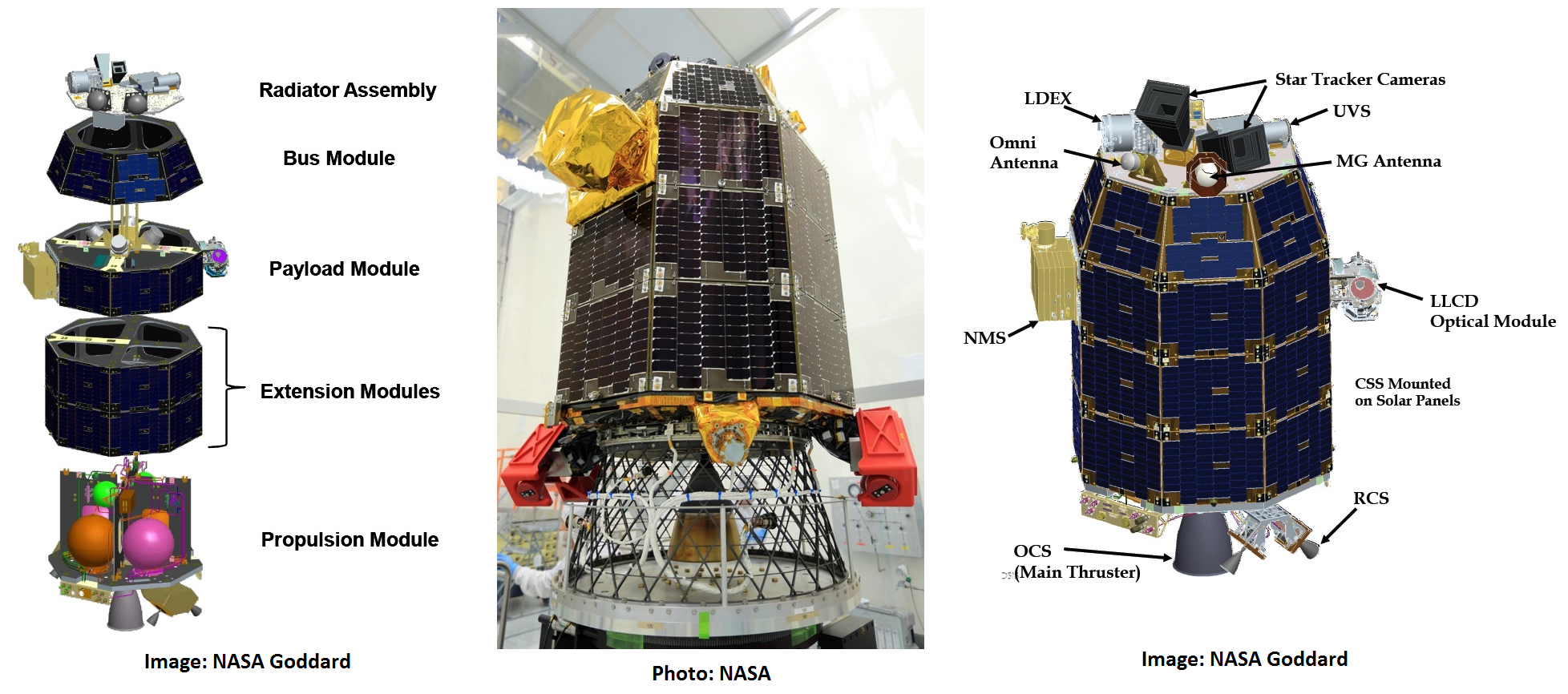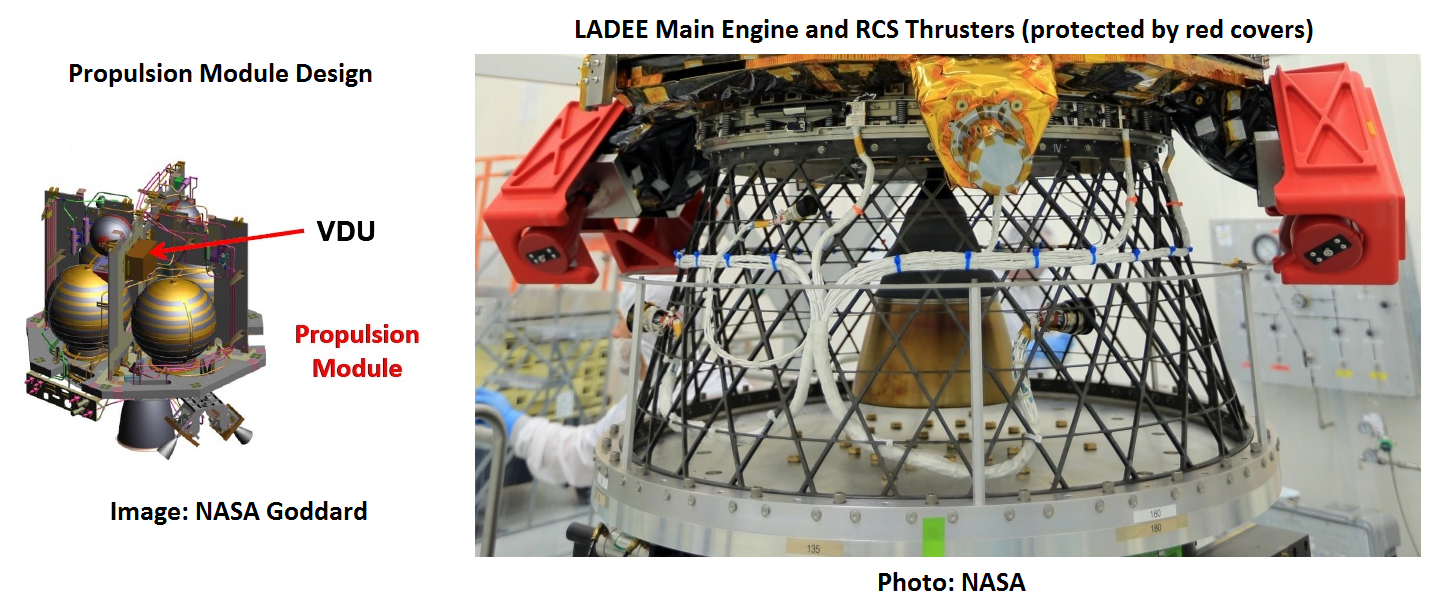Spacecraft Overview
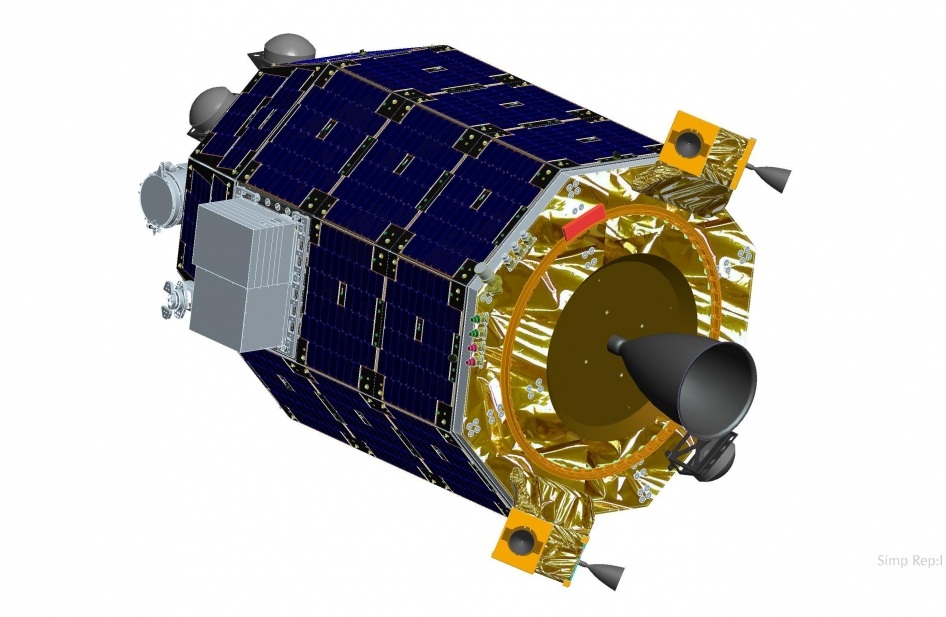
The LADEE (Lunar Atmosphere and Dust Environment Explorer) spacecraft is based on NASA’s Modular Common Spacecraft Bus (MCSB) that was developed between 2006 and 2008 at NASA’s Ames Research Center. The spacecraft bus was developed to carry a variety of scientifically useful payloads to a number of targets including lunar orbit, Low Earth Orbit, lunar surface, Earth-Moon Lagrange Points and Near Earth Objects. Easy manufacturing, parallelism in development and design, and systems components from existing flight-proven product lines contribute to making MCSB a low-cost, but highly efficient spacecraft architecture that will gain extensive flight heritage in a number of applications.
The LADEE spacecraft measures roughly 2.4 by 1.85 by 1.85 meters with a liftoff mass of 383 Kilograms. Its spacecraft bus consists of four modules that feature a lightweight carbon composite core structure to accommodate launch loads and provide attenuation of impact loads.
The four LADEE spacecraft modules consist of a Radiator Assembly that carries avionics, electrical systems, attitude sensors and payload equipment; the Bus Module; the Payload Module that facilitates the two largest payloads; and the Extension Modules that house the Propulsion Module of the spacecraft.
LADEE Spacecraft Design
Electrical System
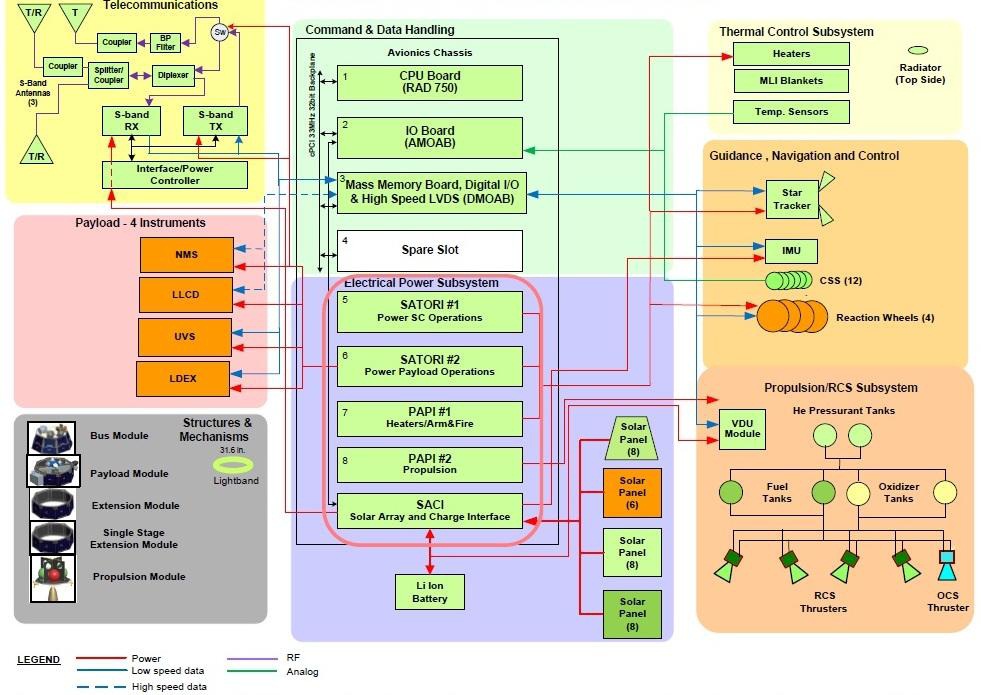
The LADEE Spacecraft features a total of 30 body mounted solar panels – there are no deployable solar arrays on the vehicle. This arrangement reduces total available power but also provides the advantage of being simpler as it eliminates failures associated with deployment and articulation of solar arrays. It also gives LADEE the ability to fly in any given attitude and still having a constant power supply which enables robust safe modes and allows science observations in different vehicle attitudes. It also allows spacecraft orientation maneuvers to be used for thermal control and eliminates a ‘cold side’ on the spacecraft which would require heaters.
Power from the solar panels is routed to the Solar Array and Charge Interface which distributes power to the individual spacecraft systems and a single Li-Ion battery that is being charged for times of higher power demand and night passes. The Solar Array and Charge Interface distributes power to two Power-switching and Pyro Integration boards (PAPI) and two SATORI Boards.
The PAPI boards route power to the Thermal Control, Guidance, Navigation & Control and the Propulsion Subsystems while the SATORI boards provide power to the Command & Data Handling System, the Telecommunications System and the four Payloads. Interface Power Controllers in the individual systems distribute power to the component level. LADEE uses a 28-Volt power bus and features switchable fuses and SATORI over-current protection.
Command & Data Handling
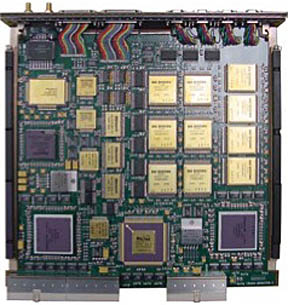
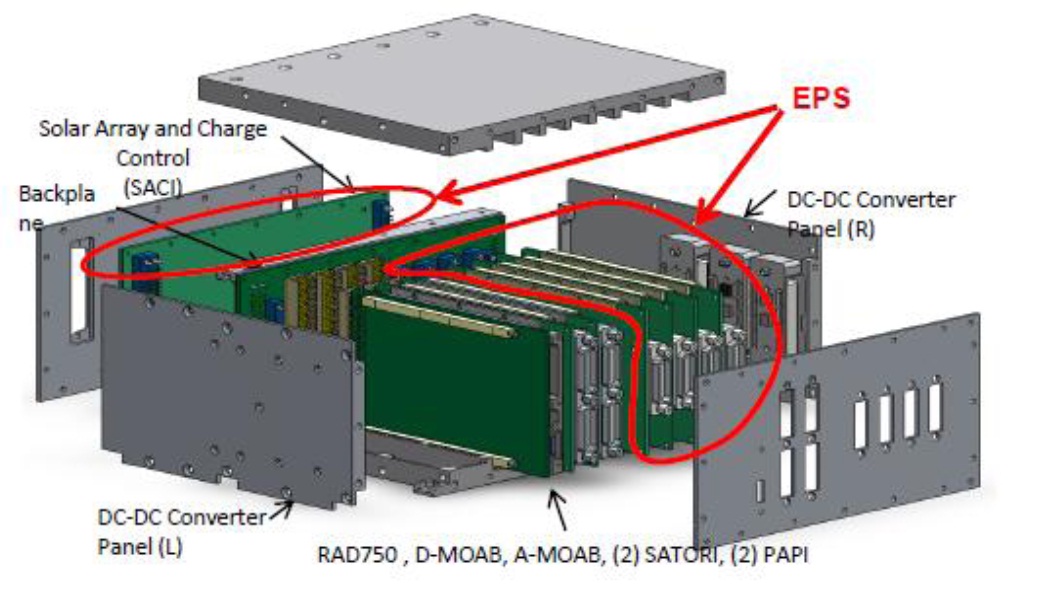
The LADEE flight avionics package consists of an eight-slot 3U cPCI (Compact Peripheral Component Interface) that hosts the SACI, PAPI & SATORI Boards of the electrical System as well as a Mass Memory Board that supports digital input/output & Low Voltage Differential Signaling for high-data rate transfers; an IO Board for data decoding/encoding; and the Central Processing Board. (The eighth slot is a spare)
The heart of the LADEE Spacecraft is a RAD-750 Central Processing Board that is a single-card computer manufactured by BAE Systems in Manassas, Va. The processor can endure radiation doses that are a million times more extreme than what is considered fatal to humans. The RAD750 CPU itself can tolerate 200,000 to 1,000,000 rads. Also, RAD750 will not suffer more than one event requiring interventions from Earth over a 15-year period.
“The RAD750 card is designed to accommodate all those single event effects and survive them. The ultimate goal is one upset is allowed in 15 years. An upset means an intervention from Earth — one ‘blue screen of death’ in 15 years. We typically have contracts that (specify) that,” said Vic Scuderi BAE Business Manager. The RAD750 processors operate at up to 200 megahertz. It operates at temperatures of -55°C and 70°C with a power consumption of 10 Watts. RAD750 can tolerate 100,000rads.
RAD-750 has plenty of flight heritage – currently being in use aboard NASA’s Juno Spacecraft, the Curiosity Rover, the two Van Allen Probes and the IRIS Solar Observatory.
The Data Handling System receives data from the payload and can send commands to the payloads as part of stored operational sequences. Data from the navigation sensors are also processed by the Data Handling Systems that in turn command the attitude control system and propulsion systems of the vehicle. Housekeeping operations such as the commanding of heaters based on temp sensor data and power management is also accomplished by the computer system.
The Mass Memory Board directly interfaces with the Telecom system of the spacecraft for data downlink and command uplink. It is also connected to the Lunar Laser Communications Demonstration Payload via a high-data rate connection to provide data for downlink.
Communications System
LADEE’s communications system uses a modular design featuring a central Interface/Power Controller that distributes electrical power to the individual components. Three S-Band antennas are mounted on the spacecraft – two of which can serve as both, Transmitter and Receiver while the third antenna is an evolved Omni-directional Medium Gain Antenna that transmits data. Developed at Ames, this antenna achieves omni-directional coverage with a smaller area of medium-gain communications. This antenna is connected to a central Transmitter Module via a coupler and BP Filter. A switch can connect the central transmitter either to the medium-gain antenna or the other two low gain antennas. The central Receiver Module is connected to a Diplexer and a Splitter/Coupler and finally the two S-Band Antennas.
The telecommunications system will be used for command uplink and science data and telemetry downlink. The Laser Communications Terminal can also be used to downlink science data, but its use is strictly experimental and part of the vehicle payload.
Propulsion System
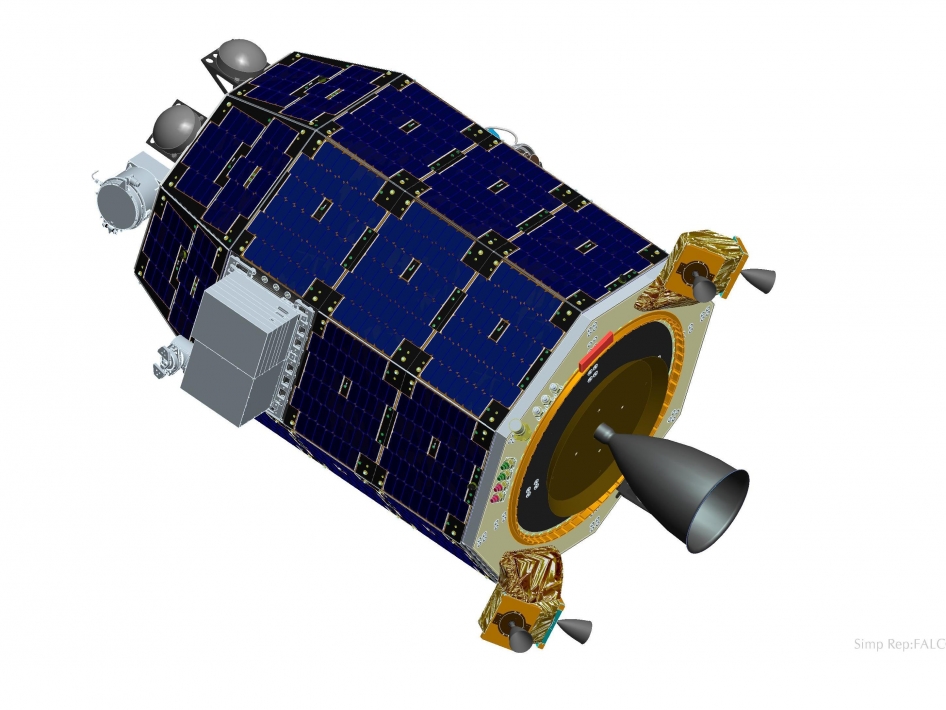
LADEE launches with a total fuel load of about 297 Kilograms which is part of a bi-propellant propulsion system featuring four Attitude Control Thrusters (the initial design included six) and a single Orbit Control Engine.
All thrusters use Monomethylhydrazine as fuel and MON-3 oxidizer (Mixed Oxides of Nitrogen: Nitrogen Tetroxide with 3% Nitrogen Monoxide). The propellants are stored in four spherical tanks that feature multi layer insulation and heaters. The propellant system uses two high-pressure Helium tanks to hold the pressurant gas. All tanks are mounted on a Thrust Cruciform that provides structural integrity to the vehicle and transfers thrust loads to the rest of the spacecraft.
The attitude control thrusters are mounted on two pods spaced 180 degrees on the base of the vehicle. Each provides 22 Newtons of thrust. ACS is used for minor orbit corrections as well as attitude maneuvers and Reaction Wheel momentum dumps. Larger orbit control maneuvers as well as trajectory corrections and the lunar orbit insertion burns are performed by the single main engine of the spacecraft.
A central VDU Module serves a separate propulsion electronics box that is in charge of valve opening and closing sequences that are requested by the Command System.
Guidance, Navigation & Control
The GNC System of the LADEE spacecraft is responsible for navigation data collection and vehicle stabilization. A Star Tracker and Inertial Measurement Unit are installed on the Radiator Assembly to determine the state of the spacecraft and provide attitude data to the Data Handling System which then commands four Reaction Wheels that are the primary attitude control system during the flight.
The four Reaction Wheels are arranged in a pyramidal fashion to provide three-axis stabilization. They are used for precise vehicle pointing as well as slew maneuvers. During Reaction Wheel momentum dumps, the RCS thrusters are used to counteract forces and so keep the vehicle stable.
In addition to the IMU and Star Trackers, LADEE uses a suite of 12 coarse sun sensors to provide state of vehicle data.
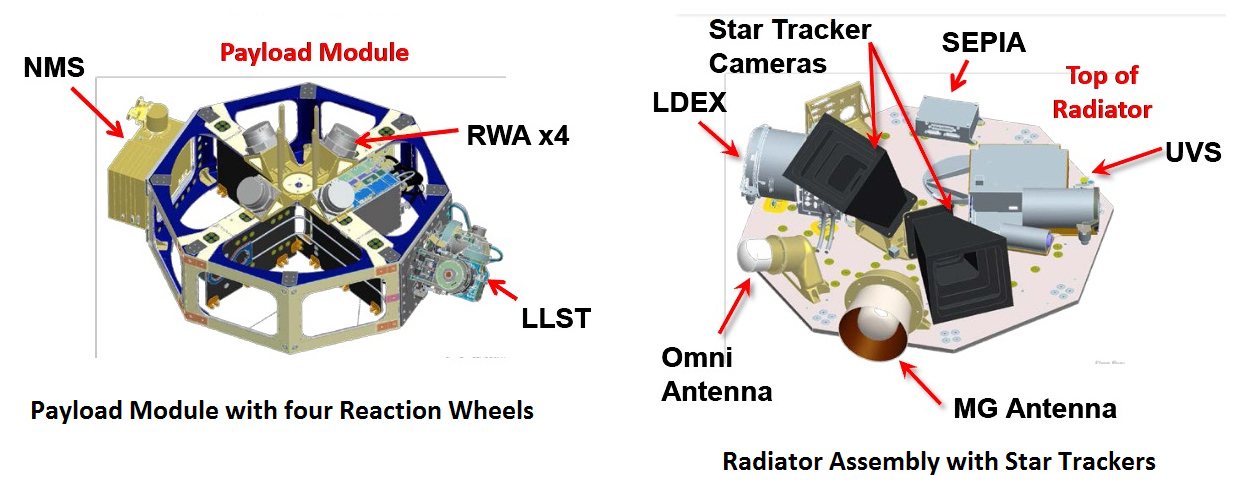
Thermal Control System
LADEE uses a combination of active and passive thermal control featuring multi layer insulation blankets, heaters and radiators. Heaters are used to keep the propellant tanks and avionics at stable operating temperature being controlled by the onboard computer that uses temp sensor data to switch the heaters on and off.
Instruments
The LADEE spacecraft hosts three instruments: NMS – the Neutral Mass Spectrometer, UVS – the Ultraviolet/Visible Spectrometer and LDEX – the Lunar Dust Experiment. In addition, the payload suite includes a single technical demonstration payload – LLCD, the Lunar Laser Communications Demonstration. The UVS and LDEX instruments are installed on top of the Radiator Assembly while the two heavier payloads, NMS and LLCD are mounted on opposite sides of the payload module to maintain a stable Center of Gravity which is important for vehicle control.

